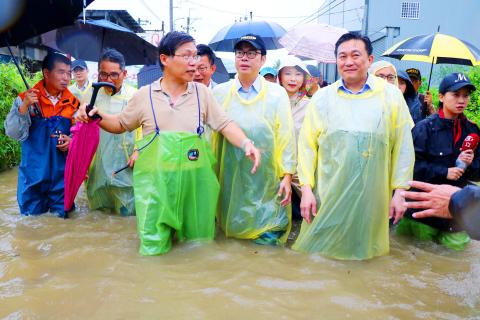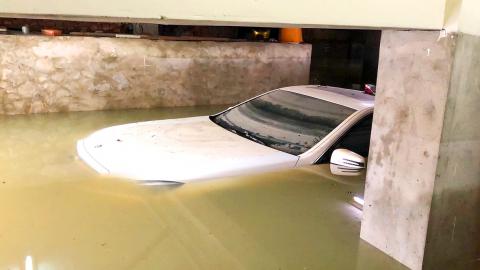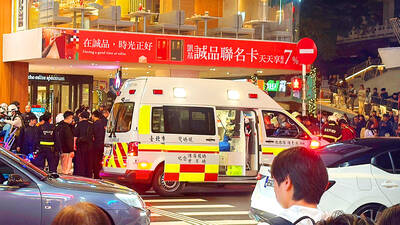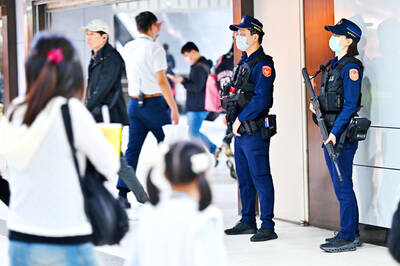Heavy rain yesterday killed a motorcyclist in Kaohsiung and forced the Tainan City Government to cancel work and classes.
The heavy rains that affected central and southern Taiwan were triggered by a southwesterly wind interacting with a convection circulation.
The Pingtung County Government closed schools and offices in Chunrih Township (春日) due to road damage.

Photo: Wan Yu-chen, Taipei Times
TV news footage showed Tainan residents pushing motorcycles through the floodwaters. In Rende District (仁德), which was severely affected, police on patrol waded through floodwaters instead of riding scooters.
Some people tried in vain to salvage their vehicles.
“When I came downstairs, my car was already deep in water. It all happened in 20 minutes,” a man told a TV news reporter.

Photo: Wang Chieh, Taipei Times
A man in Tainan’s Yongkang District (永康) said that yesterday’s rain was worse than the flooding during Typhoon Morakot in August 2009, a storm that killed 619 people.
Central Weather Bureau statistics showed that at 325.5mm Tainan received the most rain from 12am to 4pm. Pingtung followed with 279mm and Kaohsiung with 269.5mm, while two or three observation stations south of Taichung recorded rain that exceeded 100mm per hour.
Tainan nearly had torrential rain, which is 350mm of rain accumulated within 24 hours. Pingtung and Kaohsiung had extremely heavy rain, which the bureau classifies as 200mm of rain in 24 hours.
The interaction of high humidity, the southwesterly wind and convection circulation at 12am contributed to the extremely heavy rain that happened in such a short period of time, bureau forecaster Chen Yi-hsiu (陳依秀) said.
Taiwan is in a zone of low pressure, in which the southwesterly wind is the dominant force, stretching from Japan and South Korea to the Philippines and the South China Sea, Chen said, adding that the nation would experience the effects of the southwesterly wind until Sunday.
Rain is expected again in central and southern Taiwan early this morning, but it would not be as strong as yesterday, she said.
From tomorrow to Friday, the wind is expected to strengthen due to Typhoon Krosa, which is forecast to move toward Japan and South Korea today and tomorrow, she said, adding that rain is forecast from tomorrow afternoon through Friday night.
Although the possibility of torrential rain is not excluded, heavy to extremely heavy rain is forecast for central and southern Taiwan before Sunday, Chen said.
Former bureau Weather Forecast Center director Daniel Wu (吳德榮) said that the atmosphere within the monsoon trough is more unstable than the one during the plum rain season.
Its ability to trigger severe weather — including thunder and lightning, strong wind, heavy precipitation, tornadoes and consecutive heavy rain — is similar to that of the plum rain season, he added.
The southwesterly wind was produced by Tropical Depression Lekima, Weatherrisk Explore chief executive officer Peng Chi-ming (彭啟明) said.
“Typhoon Krosa’s development has strengthened the southwest monsoon, which in turn increased humidity near Taiwan and made meteorological conditions unstable along the central and southwest coasts, worsening the chances of convections, lightning and tornadoes,” Peng said.

TRAGEDY STRIKES TAIPEI: The suspect died after falling off a building after he threw smoke grenades into Taipei Main Station and went on a killing spree in Zhongshan A 27-year-old suspect allegedly threw smoke grenades in Taipei Main Station and then proceeded to Zhongshan MRT Station in a random killing spree that resulted in the death of the suspect and two other civilians, and seven injured, including one in critical condition, as of press time last night. The suspect, identified as a man surnamed Chang Wen (張文), allegedly began the attack at Taipei Main Station, the Taipei Fire Department said, adding that it received a report at 5:24pm that smoke grenades had been thrown in the station. One man in his 50s was rushed to hospital after a cardiac arrest

A car bomb killed a senior Russian general in southern Moscow yesterday morning, the latest high-profile army figure to be blown up in a blast that came just hours after Russian and Ukrainian delegates held separate talks in Miami on a plan to end the war. Kyiv has not commented on the incident, but Russian investigators said they were probing whether the blast was “linked” to “Ukrainian special forces.” The attack was similar to other assassinations of generals and pro-war figures that have either been claimed, or are widely believed to have been orchestrated, by Ukraine. Russian Lieutenant General Fanil Sarvarov, 56, head

SAFETY FIRST: Double the number of police were deployed at the Taipei Marathon, while other cities released plans to bolster public event safety Authorities across Taiwan have stepped up security measures ahead of Christmas and New Year events, following a knife and smoke bomb attack in Taipei on Friday that left four people dead and 11 injured. In a bid to prevent potential copycat incidents, police deployments have been expanded for large gatherings, transport hubs, and other crowded public spaces, according to official statements from police and city authorities. Taipei Mayor Chiang Wan-an (蔣萬安) said the city has “comprehensively raised security readiness” in crowded areas, increased police deployments with armed officers, and intensified patrols during weekends and nighttime hours. For large-scale events, security checkpoints and explosives

PUBLIC SAFETY: The premier said that security would be tightened in transport hubs, while President Lai commended the public for their bravery The government is to deploy more police, including rapid response units, in crowded public areas to ensure a swift response to any threats, President William Lai (賴清德) said yesterday after a knife attack killed three people and injured 11 in Taipei the previous day. Lai made the remarks following a briefing by the National Police Agency on the progress of the investigation, saying that the attack underscored the importance of cooperation in public security between the central and local governments. The attack unfolded in the early evening on Friday around Taipei Main Station’s M7 exit and later near the Taipei MRT’s Zhongshan